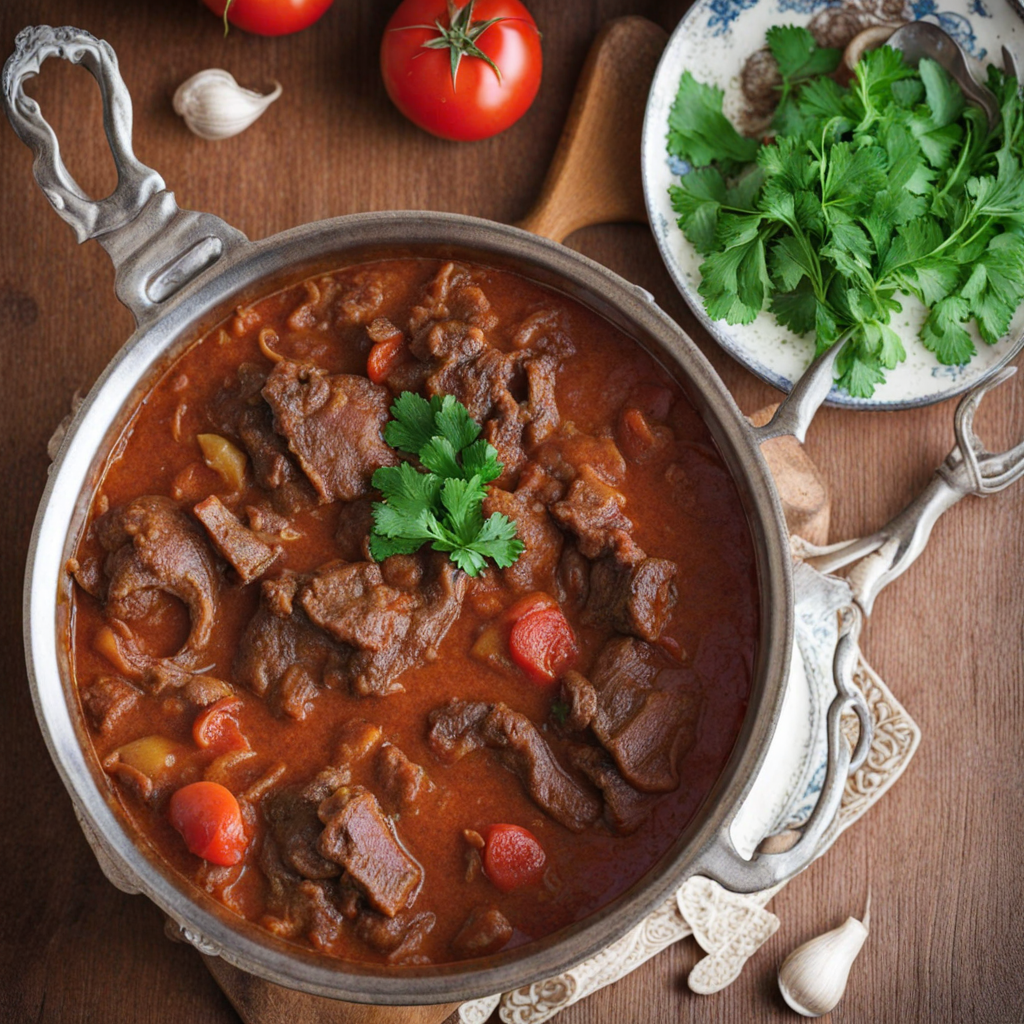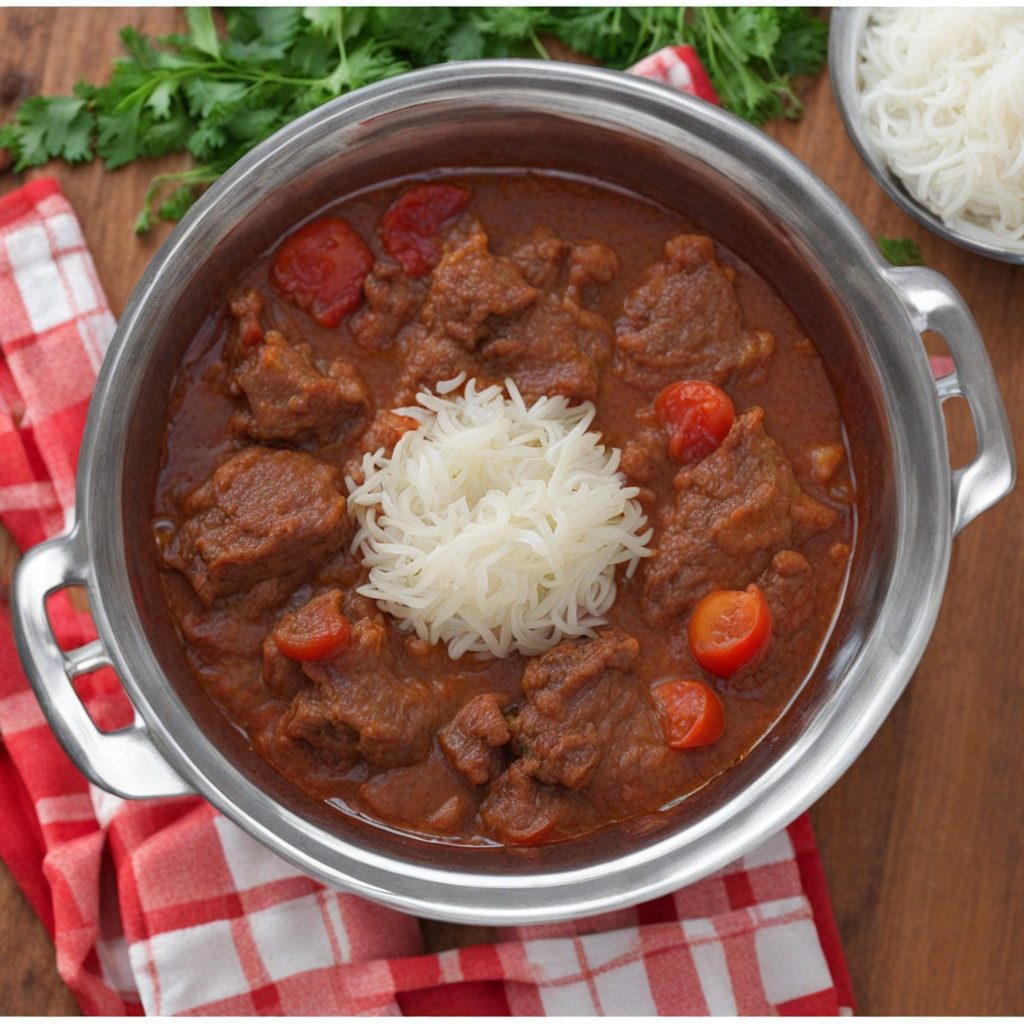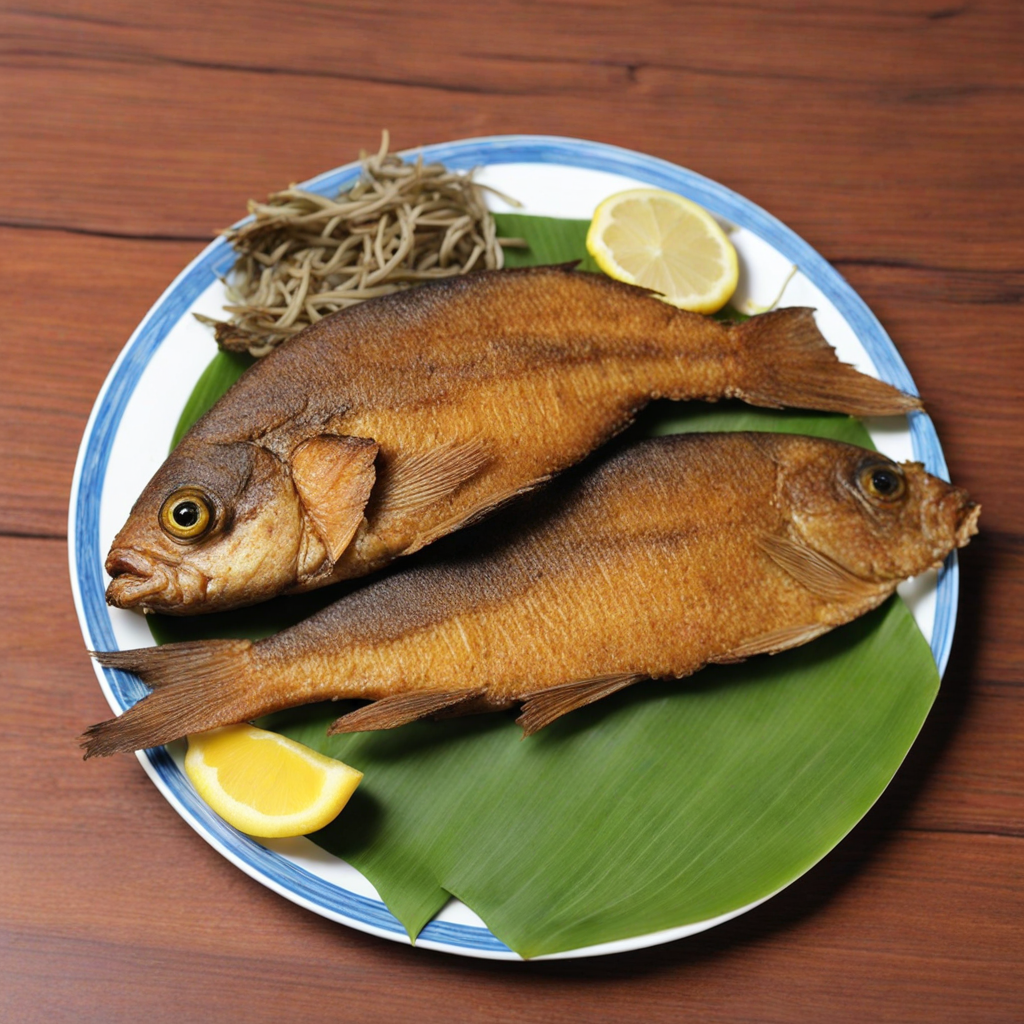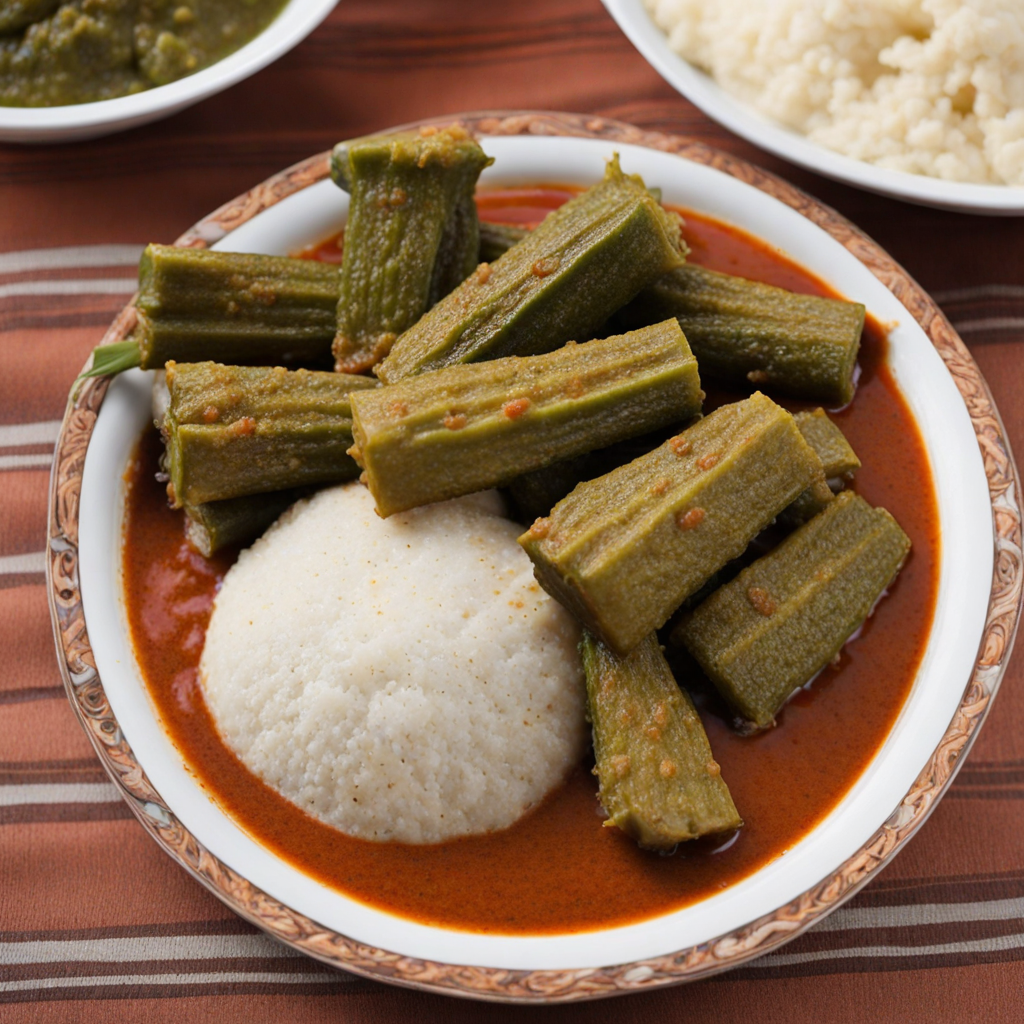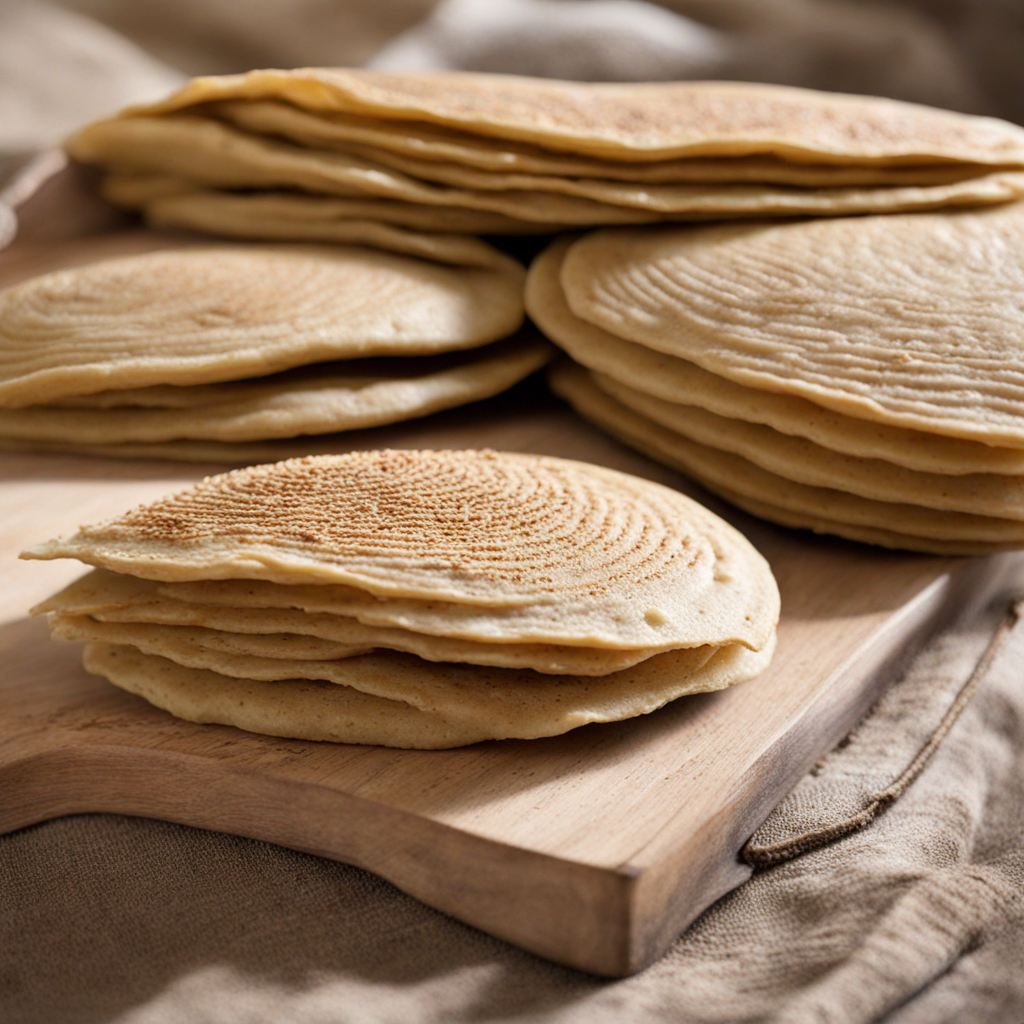Goat Meat Stew
Goat Meat Stew, or "Dawad," is a traditional dish from Chad that beautifully captures the essence of African cuisine through its rich and hearty flavors. The stew features tender pieces of goat meat, which are simmered to perfection, allowing the natural juices to meld with an array of aromatic spices. Commonly used ingredients include garlic, ginger, and a mix of local spices, creating a warm and inviting aroma that draws you in. The goat meat is often marinated beforehand, enhancing its flavor and ensuring that every bite is succulent and savory. In addition to the goat, the stew typically incorporates a variety of vegetables such as onions, tomatoes, and carrots, which add depth and texture to the dish. The vegetables not only complement the meat but also contribute to the overall richness of the stew. The cooking process involves slow simmering, which allows the flavors to develop fully and the ingredients to create a harmonious blend. The result is a thick, flavorful stew that is both comforting and satisfying. Goat Meat Stew is often served with a side of rice, couscous, or traditional Chadian porridge, making it a complete meal that can be enjoyed any time of the day. The stew's robust and earthy flavors are a testament to Chadian culinary traditions, where communal dining is celebrated. Each bowl of Dawad tells a story of heritage, showcasing the importance of goat as a staple protein in the region and highlighting the rich agricultural practices of Chad. For those seeking to explore new tastes, Goat Meat Stew offers a unique and delightful culinary experience that is sure to leave a lasting impression.
How It Became This Dish
A Culinary Journey Through 'يخنة لحم الماعز': The Goat Meat Stew of Chad Origins In the heart of Central Africa lies Chad, a nation characterized by its diverse cultures, languages, and culinary traditions. Among the many dishes that grace the tables of Chadian households, 'يخنة لحم الماعز' (Yakhnet Lahm al-Ma’az), or goat meat stew, stands out as a quintessential representation of the country's rich gastronomic heritage. The origins of this dish can be traced back to the pastoral societies that have inhabited the region for centuries, where goat herding has long been a way of life. Goats are particularly well-suited to the arid climate of Chad, which has led to their prominence in local agriculture. They are valued not only for their meat but also for their milk and hides. Consequently, goat meat has become a cornerstone of Chadian cuisine, symbolizing sustenance, community, and tradition. The use of goat meat in hearty stews reflects the need for nourishment in a landscape where resources can be scarce. Cultural Significance In Chadian culture, food is more than just sustenance; it is a vessel for social interaction, identity, and heritage. 'يخنة لحم الماعز' plays a significant role in communal gatherings and celebrations, often served during important events such as weddings, Ramadan, and festivals. The preparation of this dish is typically a communal affair, with families coming together to cook, share stories, and strengthen bonds. It embodies the spirit of hospitality that is deeply ingrained in Chadian culture. The ingredients used in 'يخنة لحم الماعز' vary across regions and communities, showcasing the diversity of Chadian cuisine. Common ingredients include fresh vegetables such as tomatoes, onions, and bell peppers, along with a variety of spices that reflect the influences of neighboring cultures. The dish is often accompanied by staple foods like rice or millet, which help balance the robust flavors of the stew. Development Over Time Over the years, 'يخنة لحم الماعز' has evolved while retaining its traditional roots. The methods of preparation have been influenced by various factors, including trade, migration, and the globalization of food. As people from different regions and backgrounds have settled in Chad, they have contributed their culinary practices, enriching the local food landscape. Traditional cooking methods in Chad often involve slow-cooking stews in a clay pot over an open flame, allowing flavors to meld and intensify. This technique has been passed down through generations, emphasizing the communal aspect of cooking. However, with the advent of modern cooking appliances, many households have begun to adapt their methods, utilizing pressure cookers and electric stoves. This shift has made the preparation of 'يخنة لحم الماعز' more efficient while still preserving the essence of the dish. The globalization of food has also led to the introduction of new ingredients and flavors into Chadian cuisine. For instance, the influence of Western and Middle Eastern cuisines has introduced spices like cumin and coriander, which have found their way into the traditional stew. This fusion of flavors showcases the adaptability of Chadian cooking and its ability to embrace new culinary trends without losing its identity. Recipes and Variations While 'يخنة لحم الماعز' remains a beloved staple, there are numerous variations that reflect local preferences and available ingredients. In urban areas, where access to diverse produce is greater, cooks might incorporate a wider range of vegetables, such as carrots, eggplants, or green beans. In contrast, rural settings may rely on whatever is locally available, often resulting in a heartier, more rustic version of the stew. A traditional recipe for 'يخنة لحم الماعز' might include the following steps: 1. Ingredients: - Goat meat (cut into pieces) - Onions (chopped) - Tomatoes (diced) - Bell peppers (sliced) - Garlic (minced) - Ginger (grated) - Ground coriander, cumin, and chili powder (to taste) - Salt and pepper - Vegetable oil - Water or broth - Fresh herbs (like parsley or cilantro) for garnish 2. Preparation: - In a large pot, heat the vegetable oil over medium heat. Add the chopped onions and sauté until translucent. - Incorporate the minced garlic and ginger, cooking for an additional minute until fragrant. - Add the goat meat to the pot, browning it on all sides. - Stir in the diced tomatoes and bell peppers, allowing them to soften slightly. - Season the mixture with ground spices, salt, and pepper, stirring well. - Pour in enough water or broth to cover the meat and vegetables, bringing it to a boil. - Reduce the heat to low, cover the pot, and let it simmer for 1.5 to 2 hours, or until the meat is tender. - Adjust seasoning as needed and garnish with fresh herbs before serving. This dish can be enjoyed with rice, couscous, or traditional Chadian bread, completing the meal with a satisfying blend of flavors and textures. Conclusion 'يخنة لحم الماعز' is more than just a delicious goat meat stew; it is a reflection of the cultural tapestry of Chad. Rooted in tradition yet open to evolution, this dish encapsulates the essence of community, resilience, and adaptability that defines Chadian society. As it continues to be prepared and enjoyed across generations, 'يخنة لحم الماعز' serves as a culinary bridge between the past and the present, celebrating the rich heritage of a nation while embracing the flavors of the world. Whether shared during a festive occasion or enjoyed in the comfort of home, this stew remains a beloved dish that connects people to their roots and to one another.
You may like
Discover local flavors from Chad


